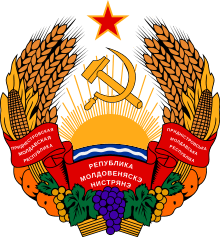Constitution of Transnistria
The current Constitution of Transnistria was approved by national referendum on 24 December 1995, and signed into law by the President of Transnistria on 17 January 1996. As part of the territory's move towards market based reforms, it was modified on 30 June 2000.
 |
|---|
| This article is part of a series on the politics and government of Transnistria |
|
| See also |
The constitution provides for a separation of powers between judicial, legislative, and executive branches. It names Russian, Ukrainian and Moldavian as the three official languages of the republic, grants religious freedom, and grants every citizen freedom of speech and the right to property. It further establishes Transnistria (a.k.a. Pridnestrovian Moldavian Republic) as an independent sovereign country with a multiparty democracy and a market economy.
In 2009, president Igor Smirnov appointed a constitutional commission, which has proposed some controversial constitutional changes.[1] The stated purpose of the new constitution is to harmonize Transnistrian legislation with that of its main guarantor state, Russia. Among the proposed changes is the introduction of a bicameral legislature (of which the lower house is to be elected and the upper house to be appointed) and the abolition of elections for rural administrations. An official draft was published on 11 September 2009.[2] Smirnov sent the draft to parliament on 23 October.[3] A referendum was planned for 24 January 2010,[4] but the proposal failed in parliament on 18 November. The draft is now to be amended once more.[5]
In June, 2011, the parliament has adopted, and in July, president has signed new amendments,[6] abolishing the post of Vice President of the Pridnestrovian Moldavian Republic (PMR), introducing the post of Prime Minister and such body as the Government of the PMR.
See also
References
- Yevgeny Shevchuk, "I call on you all to unite to protect our future, where there is the rule of law, the strong people are just, the weak people are protected, and everyone works and maintains stability”.
- Mospanov, Andrej (2009-09-11). "A new draft constitution published in Pridnestrovie" (in Russian). Olvia Press. Archived from the original on 2011-09-27. Retrieved 2009-09-28.
- "On October 23, 2009 the PMR President forwarded the new draft Constitution of the Pridnestrovian Moldavian Republic to Parliament". Supreme Council of PMR. 27 October 2009. Retrieved 2009-10-30.
- "Foreign media on Pridnestrovie: "Russia did not welcome the change of the Pridnestrovie's constitution", Konstantin Kosachev". Kommersant / Supreme Council of PMR. 27 October 2009. Retrieved 2009-10-30.
- "Parliament passed the draft resolution on the referendum". Supreme Council of PMR. 18 November 2009. Retrieved 20 November 2009.
- 2011 amendments Archived 2012-07-30 at Archive.today(in Russian)
External links
- Constitution of Transnistria (as of 2006, Russian)
- Constitution of Transnistria (as of 2000, English)